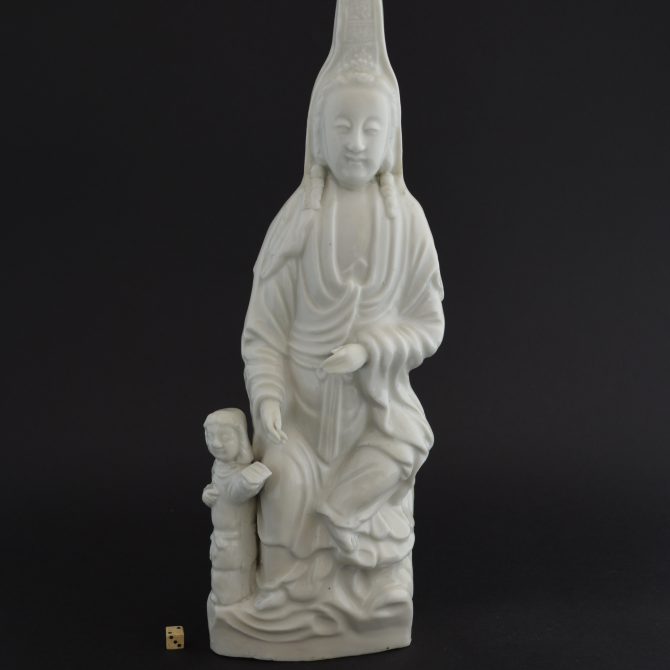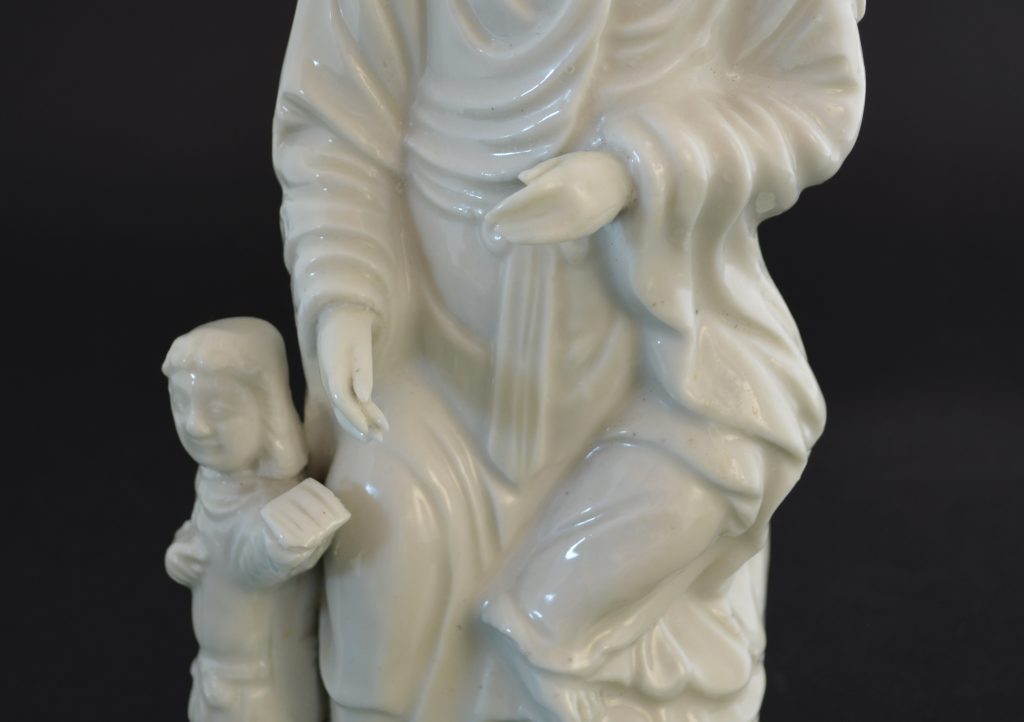
KANGXI 1662 – 1722 Blanc de Chine Porcelain
A Very Rare, Perhaps Unrecorded Blanc de Chine Model, Kangxi Period c.1690-1710, Dehua Kilns, Fujian Province. Modelled as a Lady with Her Hair in the European Fontange Style with a Diminutive Figure by Her Right Foot Who Also has a Western Hair Style.
SOLD
- Condition
- In very poor condition, repaired ; the head restuck at the neck, both hands replaced.
- Size
- Height : 33 cm (13 inches)
- Provenance
- N/A
- Stock number
- 24178
Information
Superficially this model appears to be that of Guanyin with an acolyte, propped up against a rock she is not really in a typical pose for Guanyin but her robe an cowl are more in keeping. Except that her crown is in fact a hair piece in the late 17th and very early 18th century European style called Fontange after Duchesse de Fontange. Her face appears to be in between Chinese and European as does the small male figure, who also has rather Western looking curly hair. This extraordinary is a true bleed of East and West. Other models exist that have Guanyin looking like the Virgin Mary with child but this is the only model I know of that blends Guanyin with Western fashion.
Fontange (Hair Style):
A fontange, or frelange, is a high headdress popular during the end of the late 17th and early 18th centuries in Europe. Technically, fontanges are only part of the assembly, referring to the ribbon bows which support the frelange. The frelange was supported by a wire framework called a commode. A surviving example of a frelange headdress with fontanges and commode in situ is that worn by the 1690s fashion doll Lady Clapham of c.1690-1700 (Victoria and Albert Museum, in the British Galleries, Museum number T.846-1974). In England, the style was popularly known as a `top-knot`, versions of which were worn by ladies of all ranks, from the Queen downwards to kitchen maids, making it an easy target for satire and criticism. The fontange is said to be named for the Duchesse de Fontange (Marie Angélique de Scorailles 1661-1681), a mistress of King Louis XIV of France. One version of the story is that after losing her cap while hunting with the King, the Marquise tied her hair up using a ribbon in a manner that pleased him, and this was imitated by the other ladies at court, subsequently spreading across Europe. What started out as a simple headdress of folded ribbon in the 1680s became, with additional fabric, lace and trimmings, taller and more complex, increasingly difficult to create and wear. Despite its courtly origins, fontanges were forbidden to be worn at French state occasions, although the English court accepted them, with Queen Mary having her portrait painted wearing one. The term "fontange" is also used by some writers to refer to the associated hairstyle or the combination of headdress and hairstyle.The `fontange coiffure` was a hairstyle where the front of the hair was worn curled and piled high above the forehead in front of the frelange, which was always higher than the hair. Sometimes the hairstyle was supported by a wire framework called a pallisade. Adapted from http://en.wikipedia.org/wiki/Fontange







